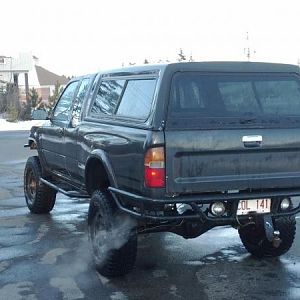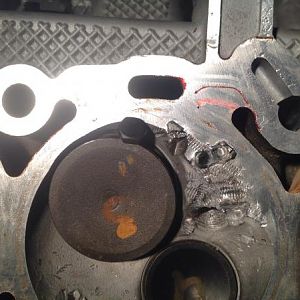Welcome to the Age of Cheap Chinese Knockoff Manufacturing. Who knows what they use to make parts? 18awg? 14awg? Well, 18 gauge bell wire is cheap so lets use that for everything. Good grief. How many of you have bought a pigtail only to find that the color coding didn't match polarity, and then got a weak signal after you figured out which wire connected to what?
Do not use common wire for vehicle applications, and trusting the spec on Chinese wires is a whole other discussion. Ok, rant is finished, on to something productive.
Typical hardware store wire is insulated with PVC, which can have a temperature max of 105ºC... but not all formulations of PVC are equal (note GPT vs TWP wires below) so you never know for sure until you use something that melts and grounds out.
Normal engine temp tops out at 220ºF, which is 105ºC. So TWP wire is right at melting temperature... so the best of PVC wires is still subject to melting if your vehicle ever runs hot for any amount of time. Cross-link is your best bet.
For anything in an engine compartment you are best off using cross-linked polyethylene (aka "cross-linked wire"), and of those SXL is probably the best because it has the thickest insulation, but is difficult to find inexpensively for home garage quantities. The best price on SXL that I could find was "by the foot" and trying to find color-coded insulation was a problem... so I elected to go with GXL. Note that TXL is NOT recognized as a Chrysler-spec option. I did not know this when I fabricated my injector and coil harnesses, I used TXL, and now I am refabricating with GXL.
Curated from
https://www.lapptannehill.com/what-are-the-differences-between-the-types-of-primary-automotive-wires
https://www.awcwire.com/automotive-wire
Name, Type, Temperature, Use, Specifications
GXL, cross-linked polyethylene (XLPE), -40°C to 125ºC, Thin wall. Most common. Engine compartments - higher heat. Chrysler Specification MS-8900 Ford Specification ESB-M1L85-B (bare copper) ESB-M1L85-A (tinned copper), S.A.E J1128
SXL, cross-linked polyethylene (XLPE), -40°C to 125ºC, Standard Wall. Engine compartments where higher resistance is needed. Chrysler Specification MS-5919 (bare copper). Ford Specification ESB-M1L85-A (bare copper). Ford Specification ESB-M1L8-A (tinned copper)
TXL, cross-linked polyethylene (XLPE), -40°C to 125ºC, Extra Thin Wall. Smallest and Lightweight., MS-8288 (bare copper). Ford Specification ESB-M1L123-A (bare copper). Ford Specification ESB-M1L123-A2 (tinned copper)
GPT, polyvinylchloride (PVC), -40°C to 85ºC, General Circuit Wiring, S.A.E J 1128
TWP, polyvinylchloride (PVC), -40°C to 105ºC, Thin Wall. Lightweight and Small., S.A.E J 1128
HDT, polyvinylchloride (PVC), -40°C to 85ºC, General Circuit Wire. Thickest Wall., SAE J-1128, Ford M1L-50A, Chrysler MS-3494
If you are going to do your own wiring get yourself a good crimping tool, non-insulated butt connectors for the correct gauge range, and some heat-shrink tubing.
Do not use common wire for vehicle applications, and trusting the spec on Chinese wires is a whole other discussion. Ok, rant is finished, on to something productive.
Typical hardware store wire is insulated with PVC, which can have a temperature max of 105ºC... but not all formulations of PVC are equal (note GPT vs TWP wires below) so you never know for sure until you use something that melts and grounds out.
Normal engine temp tops out at 220ºF, which is 105ºC. So TWP wire is right at melting temperature... so the best of PVC wires is still subject to melting if your vehicle ever runs hot for any amount of time. Cross-link is your best bet.
For anything in an engine compartment you are best off using cross-linked polyethylene (aka "cross-linked wire"), and of those SXL is probably the best because it has the thickest insulation, but is difficult to find inexpensively for home garage quantities. The best price on SXL that I could find was "by the foot" and trying to find color-coded insulation was a problem... so I elected to go with GXL. Note that TXL is NOT recognized as a Chrysler-spec option. I did not know this when I fabricated my injector and coil harnesses, I used TXL, and now I am refabricating with GXL.
Curated from
https://www.lapptannehill.com/what-are-the-differences-between-the-types-of-primary-automotive-wires
https://www.awcwire.com/automotive-wire
Name, Type, Temperature, Use, Specifications
GXL, cross-linked polyethylene (XLPE), -40°C to 125ºC, Thin wall. Most common. Engine compartments - higher heat. Chrysler Specification MS-8900 Ford Specification ESB-M1L85-B (bare copper) ESB-M1L85-A (tinned copper), S.A.E J1128
SXL, cross-linked polyethylene (XLPE), -40°C to 125ºC, Standard Wall. Engine compartments where higher resistance is needed. Chrysler Specification MS-5919 (bare copper). Ford Specification ESB-M1L85-A (bare copper). Ford Specification ESB-M1L8-A (tinned copper)
TXL, cross-linked polyethylene (XLPE), -40°C to 125ºC, Extra Thin Wall. Smallest and Lightweight., MS-8288 (bare copper). Ford Specification ESB-M1L123-A (bare copper). Ford Specification ESB-M1L123-A2 (tinned copper)
TWP, polyvinylchloride (PVC), -40°C to 105ºC, Thin Wall. Lightweight and Small., S.A.E J 1128
If you are going to do your own wiring get yourself a good crimping tool, non-insulated butt connectors for the correct gauge range, and some heat-shrink tubing.










